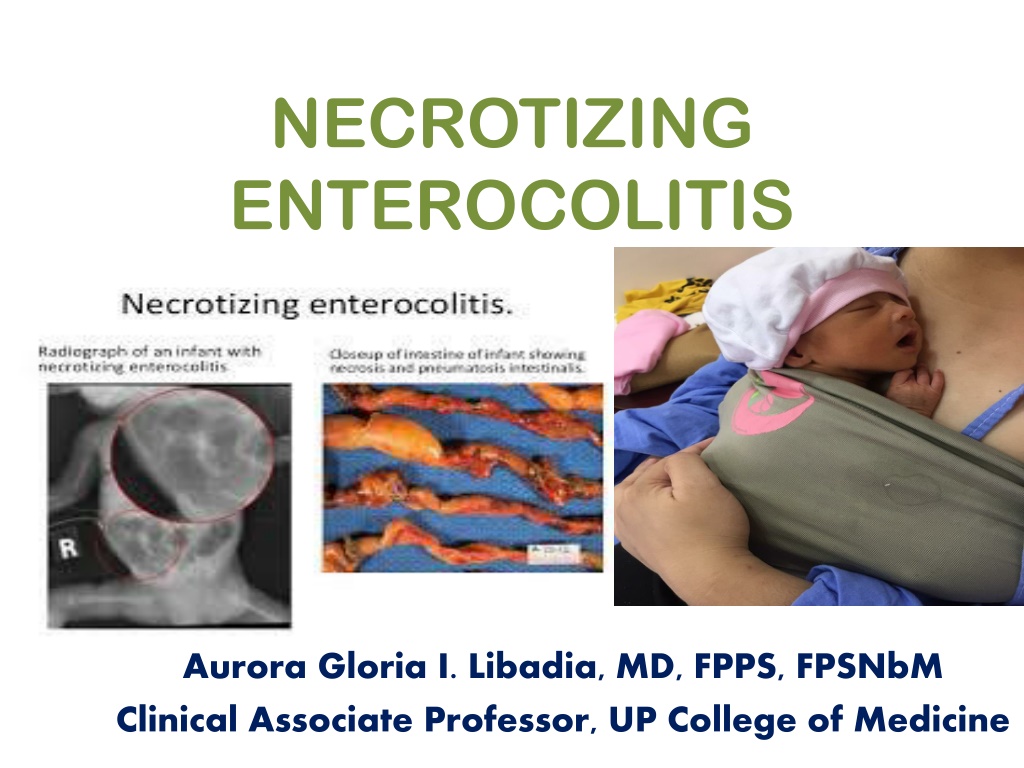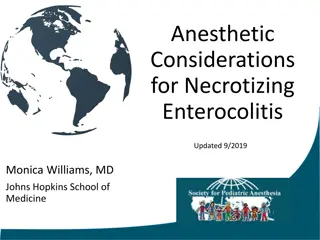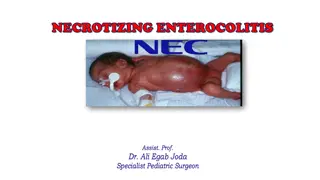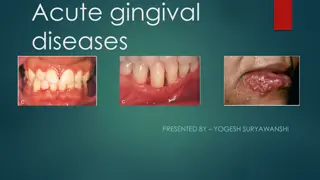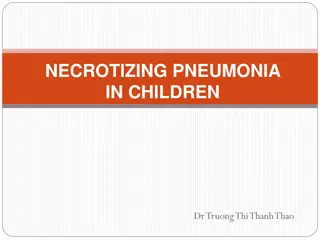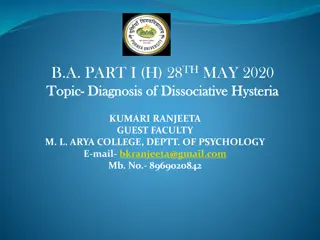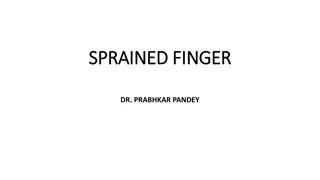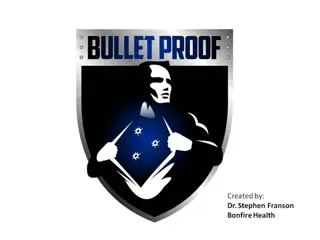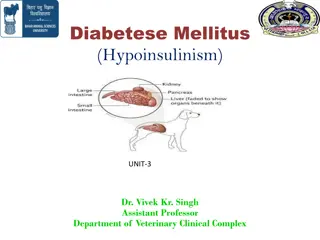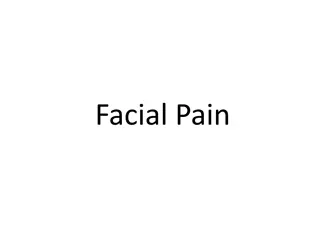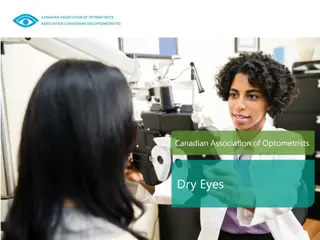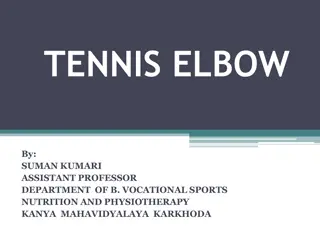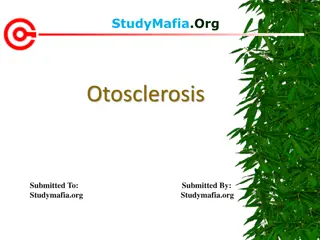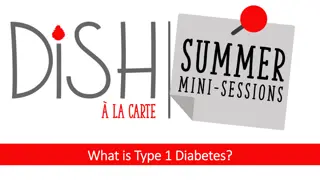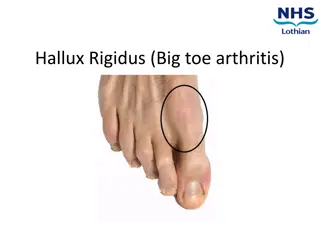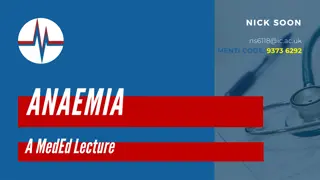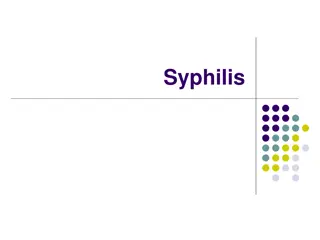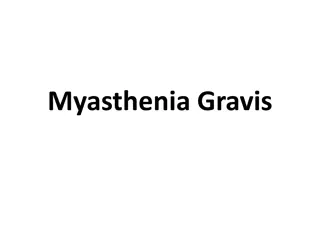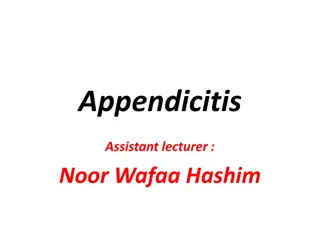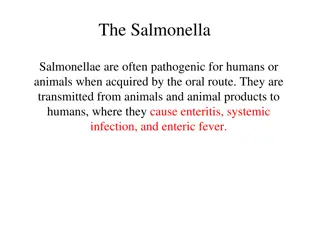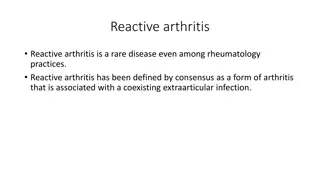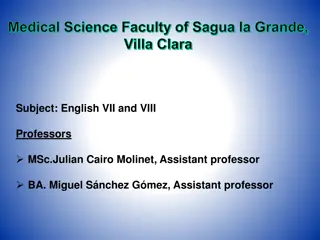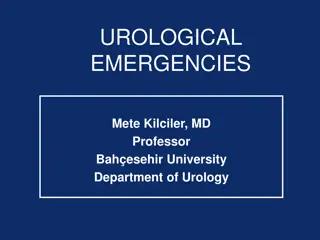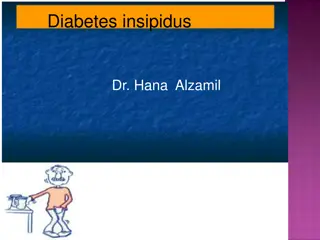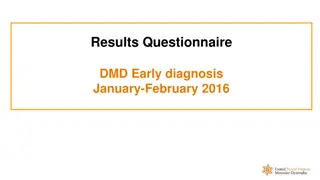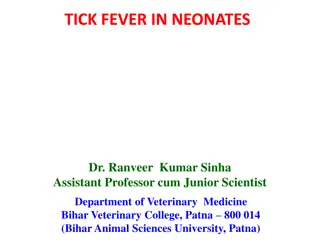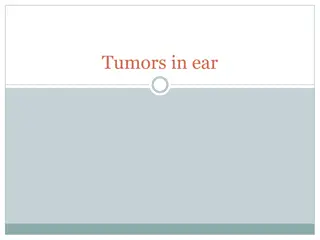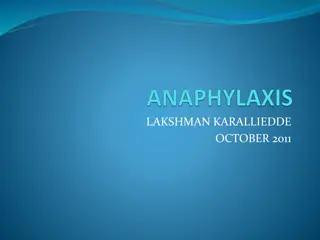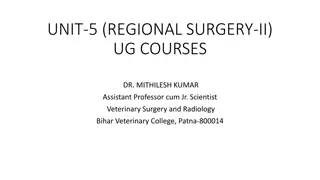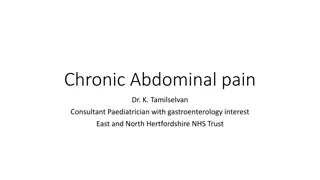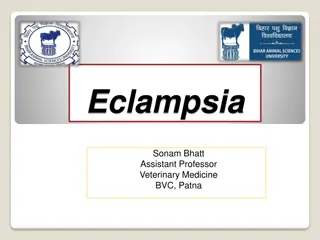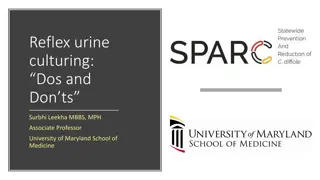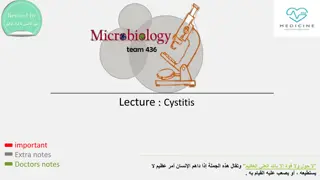Necrotizing Enterocolitis: Causes, Symptoms, Diagnosis, and Treatment
Necrotizing Enterocolitis (NEC) is a serious condition affecting mainly premature infants, with unknown exact causes but potential risk factors like impaired mucosal barrier and feeding issues. Clinical manifestations include feeding intolerance, abdominal distention, and blood in stools. Diagnosis involves imaging studies like abdominal X-rays. Treatment follows a modified Bell Staging system targeting systemic and intestinal signs, including antibiotics and supportive care.
Download Presentation

Please find below an Image/Link to download the presentation.
The content on the website is provided AS IS for your information and personal use only. It may not be sold, licensed, or shared on other websites without obtaining consent from the author. Download presentation by click this link. If you encounter any issues during the download, it is possible that the publisher has removed the file from their server.
E N D
Presentation Transcript
NECROTIZING ENTEROCOLITIS Aurora Gloria I. Libadia, MD, FPPS, FPSNbM Clinical Associate Professor, UP College of Medicine
Outline WHO are affected ? WHY? WHAT are the clinical manifestation ? HOW to Diagnose? HOW to Treat?
NEC Premature LBW infants ( Less than 35 weeks old , weighing less than 1000 grams ) comprise 90% of cases are at a higher risk
Etiology Unknown Impaired mucosal barrier Pathogenic bacteria Feeding with milk formula Hypoxia or hypotension
Etiology CHD Prophylactic PDA closure with Indomethacin, 30% risk of NEC Combination of CHD and NEC increased overall mortality rate to 55% Anemia and pRBC transfusion - it is hypothesized that intestinal vascular autoregulation occurs after correction of anemia leading to transfusion related acute GUT injury
Clinical manifestation Premature Feeding intolerance (vomiting or increased gastric residuals Abdominal distention Fecal occult blood positive Gross blood on stool
Diagnosis Abdominal Xray ileus later subserosal air collections (pneumatosis intestinalis) Perforation Portal vein gas intestinal necrosis Thrombocytopenia
Treatment Modified Bell Staging for NEC STAGE SYSYTEMIC SIGNS INTESTINAL RADIOLOGIC SIGNS TREATMENT SIGNS I. SUSPECTED A Temperature instability Apnea Bradycardia Elevated pregavage residuals, mild abdominal distention, Occult blood in stool Normal or mild ileus NPO x 3 days Antibiotics B Same as IA Same as IA Plus Gross blood in stool Same as IA Same as IA From Walsh MC, Kleigman RM, Fanaroff AA. Necrotizing enterocolitis: a practitioners perspective; 1998
Treatment Modified Bell Staging for NEC SYSYTEMIC SIGNS INTESTINAL SIGNS STAGE RADIOLOGIC SIGNS TREATMENT II. DEFINITE A. Mildly ill Same as for IA Same as for I, plus Absent bowel sounds Abdominal tenderness Ileus, intestinal pneumatosis NPO,x 7-10 days Antibiotics B. Moderately ill Same as for I, plus mild metabolic acidosis, Mild thrombocytopeni a Same as for I, Absent bowel sounds,definite Abdominal tenderness, abdominal cellulitus, right lower quadrant mass Same as for IIA, plus portal vein gas with or without ascites NPO, x 14 days Antibiotics From Walsh MC, Kleigman RM, Fanaroff AA. Necrotizing enterocolitis: a practitioners perspective;1998
Treatment Modified Bell Staging for NEC STAGE SYSYTEMIC SIGNS INTESTINAL RADIOLOGIC SIGNS TREATMENT SIGNS III. Advanced A. Severely ill, bowel intact Same as for IIB plus hypotension, bradycardia, respiratory acidosis, metabolic acidosis, DIC, neutropenia Same as for I and II, plus signs of generalized peritonitis, marked tenderness and distention of abdomen Same for IIB plus definite ascites NPO, antibiotics x 14 days, fluid resuscitation, inotrophic support,ventilator therapy, paracentesis B. Severely ill, bowel perforated Same as for IIIA Same as for IIIA Same for IIB plus Pneumoperitone um Same as for IIA, plus surgery From Walsh MC, Kleigman RM, Fanaroff AA. Necrotizing enterocolitis: a practitioners perspective;1998
Storage of breast milk Room air Refrigerator Freezer (one door compartment ) 2 weeks Freezer (two door compartment) Deep freezer 6-12 months Cooler with frozen gel packs/ice 24 hours 4-6 hours 1-8 days 3 months
Take Home Message Strict infection control measures Breastmilk feeding Management of Sepsis Prevention of hypoxia and hypotension
Reference Fundamentals of Pediatrics Competency based
Questions 1. The baby has found the breast and nipple and started to suck. It is normal for the mother to: a. Complain of pain in her nipple as it is the first time she has felt a baby suck at her breast b.Want reassurance the baby is sucking well and is getting something c.Stimulate the baby to keep sucking d.All of the above
Questions 1. The baby has found the breast and nipple and started to suck. It is normal for the mother to: a. Complain of pain in her nipple as it is the first time she has felt a baby suck at her breast b.Want reassurance the baby is sucking well and is getting something c.Stimulate the baby to keep sucking d.All of the above
Questions 2. Signs of optimal attachment are: a. Mother says her breasts and nipples are comfortable during sucking after the first few sucks b. Baby s chin is well in to the breast during feeds and deep jaw movements during sucking cycle c. Cheeks are full and not dimpled when sucking d.All of the above
Questions 2. Signs of optimal attachment are: a. Mother says her breasts and nipples are comfortable during sucking after the first few sucks b. Baby s chin is well in to the breast during feeds and deep jaw movements during sucking cycle c. Cheeks are full and not dimpled when sucking d.All of the above
Questions 3. The mother complains that she feels a pinching pain in her nipple when the baby is sucking. You advise the mother to: a. Keep feeding, she will get used to it b. Take the baby off by gently putting her finger into the corner of the baby s mouth to break the suction and try to attach again c. Take the baby off by gently putting her finger into the corner of the baby s mouth to break the suction and settle the baby because the baby must have had enough d. Take the baby off and give the baby some formula until her nipple feels better
Questions 3. The mother complains that she feels a pinching pain in her nipple when the baby is sucking. You advise the mother to: a. Keep feeding, she will get used to it b. Take the baby off by gently putting her finger into the corner of the baby s mouth to break the suction and try to attach again c. Take the baby off by gently putting her finger into the corner of the baby s mouth to break the suction and settle the baby because the baby must have had enough d. Take the baby off and give the baby some formula until her nipple feels better
Questions 4. A preterm baby, day 5 of life , was born 26 weeks by pediatric aging 650 grams , eith episodes of apnea, bradycardia, feeding residulas and abdominal distension . Radiographic findings showed : Ileus with pneumatosis intestinalis . The most likely diagnosis is : a. NEC Stage IA b. NEC Stage IIA c. NEC Stage IIB d. NEC Stage IIIA
Questions 4. A preterm baby, day 5 of life , was born 26 weeks by pediatric aging 650 grams , with episodes of apnea, bradycardia, feeding residulas and abdominal distension . Radiographic findings showed : Ileus with pneumatosis intestinalis . The most likely diagnosis is : a. NEC Stage IA b. NEC Stage IIA c. NEC Stage IIB d. NEC Stage IIIA
